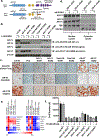Role of androgen receptor splice variant-7 (AR-V7) in prostate cancer resistance to 2nd-generation androgen receptor signaling inhibitors
- PMID: 32989253
- PMCID: PMC7655549
- DOI: 10.1038/s41388-020-01479-6
Role of androgen receptor splice variant-7 (AR-V7) in prostate cancer resistance to 2nd-generation androgen receptor signaling inhibitors
Erratum in
-
Correction to: Role of androgen receptor splice variant-7 (AR-V7) in prostate cancer resistance to 2nd-generation androgen receptor signaling inhibitors.Oncogene. 2021 Mar;40(11):2148. doi: 10.1038/s41388-021-01640-9. Oncogene. 2021. PMID: 33564077 No abstract available.
-
Correction: Role of androgen receptor splice variant-7 (AR-V7) in prostate cancer resistance to 2nd-generation androgen receptor signaling inhibitors.Oncogene. 2021 Jun;40(22):3914-3916. doi: 10.1038/s41388-021-01805-6. Oncogene. 2021. PMID: 33958727 No abstract available.
Abstract
The role of truncated androgen receptor splice variant-7 (AR-V7) in prostate cancer biology is an unresolved question. Is it simply a marker of resistance to 2nd-generation androgen receptor signaling inhibitors (ARSi) like abiraterone acetate (Abi) and enzalutamide (Enza) or a functional driver of lethal resistance via its ligand-independent transcriptional activity? To resolve this question, the correlation between resistance to ARSi and genetic chances and expression of full length AR (AR-FL) vs. AR-V7 were evaluated in a series of independent patient-derived xenografts (PDXs). While all PDXs lack PTEN expression, there is no consistent requirement for mutation in TP53, RB1, BRCA2, PIK3CA, or MSH2, or expression of SOX2 or ERG and ARSi resistance. Elevated expression of AR-FL alone is sufficient for Abi but not Enza resistance, even if AR-FL is gain-of-function (GOF) mutated. Enza resistance is consistently correlated with enhanced AR-V7 expression. In vitro and in vivo growth responses of Abi-/Enza-resistant LNCaP-95 cells in which CRISPR-Cas9 was used to knockout AR-FL or AR-V7 alone or in combination were evaluated. Combining these growth responses with RNAseq analysis demonstrates that both AR-FL- and AR-V7-dependent transcriptional complementation are needed for Abi/Enza resistance.
Figures







References
-
- Bellur S, Van der Kwast T, Mete O. Evolving concepts in prostatic neuroendocrine manifestations: from focal divergent differentiation to amphicrine carcinoma. Hum Pathol 2018. - PubMed
-
- Berchem GJ, Bosseler M, Sugars LY, Voeller HJ, Zeitlin S, Gelmann EP. Androgens induce resistance to bcl-2-mediated apoptosis in LNCaP prostate cancer cells. Cancer Res 1995; 55: 735–738. - PubMed
-
- Chen CD, Welsbie DS, Tran C, Baek SH, Chen R, Vessella R et al. Molecular determinants of resistance to antiandrogen therapy. Nat Med 2004; 10: 33–39. - PubMed
Publication types
MeSH terms
Substances
Grants and funding
LinkOut - more resources
Full Text Sources
Molecular Biology Databases
Research Materials
Miscellaneous

